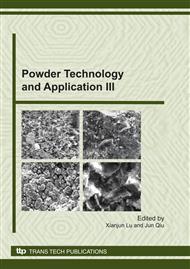p.64
p.71
p.76
p.81
p.97
p.106
p.113
p.125
p.130
Effect of Preparation Parameters on the Structure and Property of Montmorillonite/Alkylammonium Complexes
Abstract:
A series of montmorillonite/alkylammonium complexes were prepared by the intercalation reaction between montmorillonite and Octadecyltrimethylammonium chloride (OTA). The effects of OTA dosage and intercalation duration on the structure and gelating properties of the complexes were investigated. And, the correlation between the structure of complexes and their gel viscosities were discussed. Results indicate that the OTA dosage and retention time have remarkable influence on the structure and gelating properties of montmorillonite/alkylammonium complexes, and the gelating properties also relates to the arrangement of the alkylammonium molecules in the interlayers of montmorillonite. Along with the increase of the OTA dosage under the same retentation time, both the d001 value of the montmorillonite/alkylammonium complexes and the adsorption amount of OTA increase to some extent, and the layer structure of the complex tends to show an interstratification structure. However, maximum gel viscosity of the complex was obtained at a moderate OTA dosage of 1.1~1.3CEC. Along with the increase of the retentation time, the adsorption amount of the OTA shows little variations, but the interlayer structure of the complex prepared under longer retention time tends to form a stable monolayer structure from an unstable interstratification structure under shorter retention time, and the gel viscosity of the complex increases gradually to the maximum value.
Info:
Periodical:
Pages:
97-105
Citation:
Online since:
November 2010
Authors:
Keywords:
Price:
Сopyright:
© 2011 Trans Tech Publications Ltd. All Rights Reserved
Share:
Citation:


